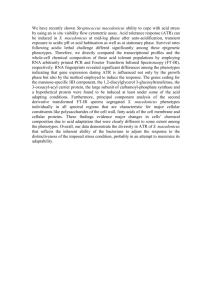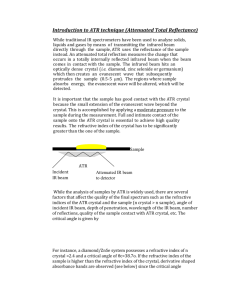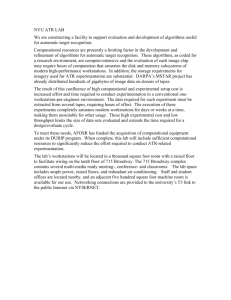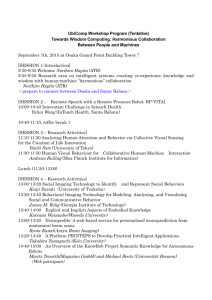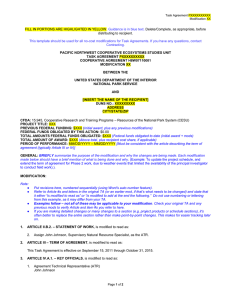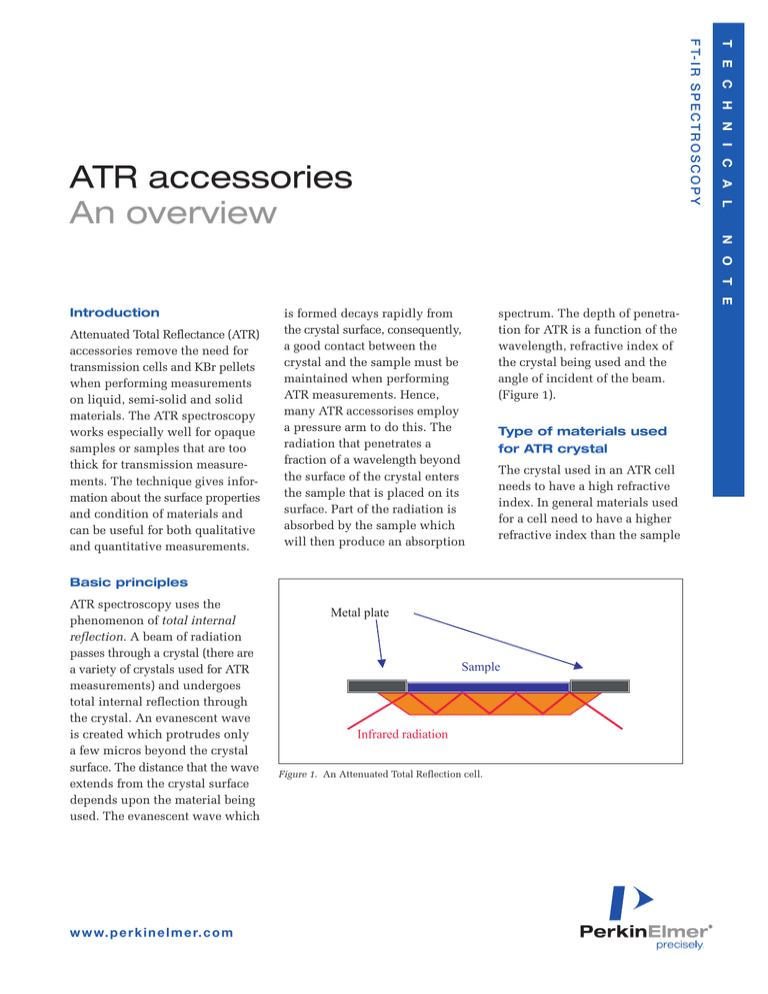
T E C H N I C A L
F T- I R S P E C T R O S C O P Y
ATR accessories
An overview
N O T E
Introduction
Attenuated Total Reflectance (ATR)
accessories remove the need for
transmission cells and KBr pellets
when performing measurements
on liquid, semi-solid and solid
materials. The ATR spectroscopy
works especially well for opaque
samples or samples that are too
thick for transmission measurements. The technique gives information about the surface properties
and condition of materials and
can be useful for both qualitative
and quantitative measurements.
is formed decays rapidly from
the crystal surface, consequently,
a good contact between the
crystal and the sample must be
maintained when performing
ATR measurements. Hence,
many ATR accessorises employ
a pressure arm to do this. The
radiation that penetrates a
fraction of a wavelength beyond
the surface of the crystal enters
the sample that is placed on its
surface. Part of the radiation is
absorbed by the sample which
will then produce an absorption
spectrum. The depth of penetration for ATR is a function of the
wavelength, refractive index of
the crystal being used and the
angle of incident of the beam.
(Figure 1).
Type of materials used
for ATR crystal
The crystal used in an ATR cell
needs to have a high refractive
index. In general materials used
for a cell need to have a higher
refractive index than the sample
Basic principles
ATR spectroscopy uses the
phenomenon of total internal
reflection. A beam of radiation
passes through a crystal (there are
a variety of crystals used for ATR
measurements) and undergoes
total internal reflection through
the crystal. An evanescent wave
is created which protrudes only
a few micros beyond the crystal
surface. The distance that the wave
extends from the crystal surface
depends upon the material being
used. The evanescent wave which
w w w. p e r k i n e l m e r. c o m
Metal plate
Sample
Infrared radiation
Figure 1. An Attenuated Total Reflection cell.
Table 1. Physical properties of commonly used ATR crystals
Materials
Spectral range (cm-1)
Refractive index
Depth of
penetration µm.
Diamond
4,5000-2,500
1,667-33
2.4
1.66
Ge
5,500
4
0.65
KRS-5
20,000-400
2.37
1.73
Si
8,300-1,500
360-70
2.37
1.73
ZnSe
20,000-650
2.4
1.66
index to that of zinc selenide and
is mainly used in measurement
with strong acids.
Type of ATR accessories
There are a variety of ATR accessories available on the market,
choosing the correct accessories
for the sample is critical when
looking to obtain the correct result.
Horizontal ATR (H-ATR)
being measured. The table above
(Table 1) shows typical physical
properties of the materials that are
commonly used in ATR cells.
Diamond: Diamond has excellent
chemical and physical properties
when used as ATR material. Its hard
scratch resistant properties make it
suitable for a wide range of applications. It can withstand highly acidic
and basic samples and does not
react with strongly oxidizing or
complex agents. Diamond ATRs
can be used to analyze hard powder
solid samples. The only disadvantage with diamond is it’s relatively
high absorbance in the region of
2,500cm-1 to 1,650cm-1.
Germanium: Due to it high refractive index, germanium is excellent
for highly absorbing samples e.g.
rubber materials containing carbon
black. Due to it low depth of
penetration germanium ATR is
useful for analysis of a single layer
in laminate samples.
KRS-5: Thallium-bromoiodide
has the widest spectral range of
commonly used ATR crystals,
however, it is soft and can be easily
damaged. KRS-5 is insoluble in
water but will form a surface bloom
which makes it unsuitable for use
with aqueous samples. Caution
must be taken when using KRS-5
due to its high toxicity.
2
Zinc Selenide: This material has
the advantage of being resistant to
many commercially available acids
and alkalis and is water resistant,
Figure 2. Horizontal-ATR.
which makes it easy to clean and
ideal for wet or aqueous samples.
Zinc selenide has a similar refractive index to that of diamond,
which make it a cost effective
alternative for some applications.
Silicon: Silicon has a high refractive
index which makes it applicable for
high absorbing samples. Silicon is
also scratch and water resistance.
With its low depth of penetration,
silicon is ideal for the analyses of
thin film samples. However, the
material is affected by strong acids
and alkali and also has a limited
spectral range.
AMTIR: This crystal is manufactured from selenium, arsenic and
germanium and is insoluble in
water. It has a similar refractive
There are many arrangements of
this accessory but the most common
being a top-mounted prism (Figure 2)
that will allow the analysis of solids,
liquids and pastes. Liquid samples
are easy to analyze by pouring a
small amount of the sample into
a trough plate or casting a film.
For routine applications conducted
within the industry, the H-ATR
offers a clear advantage over classical
transmission techniques to due its
higher sample throughput gained
by the reduced sample preparation
time. The results obtained from the
analysis of certain solids may vary
when using an H-ATR. Hard solid
materials with an irregular surface
can give poor contact with the
crystal, however, softer materials
will form good sample crystal
contact e.g. low molecular weight
polymer (Figure 3).
Metal mounting plate:
316 S/S or Hastalloy
Diamond IRE
ZnSe (or KRS-5)
focusing element
Figure 3. Schematic of a Universal-ATR top plate.
Universal ATR (UATR)
UATR is a versatile ATR accessory
ideal for the analysis of solids,
liquids, pastes and gels. The UATR
employs a DiCompTM crystal, which
is composed of a diamond ATR with
a zinc selenide focusing element
which is in direct contact with the
diamond. The focusing element
provides interfacing optics for the
IR radiation into the diamond crystal.
Both components of the DiComp
ATR work over the spectral range of
interest for the majority of applications and have similar refractive
indices. The radiation enters the
focusing element through the flat
surface. To allow reflection within
the diamond, the focusing crystal
has a small cavity at the center of
it’s surface (Figure 4). The radiation
undergoes internal reflection in the
diamond which is in contact with
the sample and then exits the crystal
at a point which is diametrically
opposite to the point of entry.
There are significant advantages
to this design. The shorter optical
path within the ATR reduces the
loss of energy through the crystal
caused by internal reflections. The
DiComp crystal has the benefits of
diamond (hardness and chemical
resistance) and the cost effectiveness of zinc selenide.
powders or powders which have a
coating applied. Another advantage
of DRIFTS is that samples can be
easily analysed without the need for
laborious sample preparation.
Diffuse Reflectance
Infrared Transform
Spectrcopy (DRIFTS)
The diffuse radiation reflected from a
sample is normally distributed over
a wide angle so the accessory needs
to be able to collect this radiation
effectively. A basic schematic is
shown (Figure 6).
When infrared radiation falls on a
surface, depending upon the nature
of the material, it may be absorbed
Conclusion
Figure 5. Universal-ATR accessories.
specular reflectance i.e. energy that
is not absorbed by the sample,
internally reflected or diffusely
scattered as shown (Figure 5).
DRIFTS is predominately used for
the analysis of powders and is a
good alternative to using an UATR
when conducting analysis of hard
Figure 4. Schematic representation of DRIFTS accessories.
Attenuated total reflectance spectroscopy is an ideal technique for
the analysis of samples that are more
demanding to measuring than using
traditional transmission techniques.
Moreover, reduced sample preparation allows ATR to lend itself to
industrial applications where higher
sample throughput can be an
important factor. Also, for users of
infrared who are less familiar with
the technique or who are starting
to gain practical experience of IR
spectroscopy, ATR allows them to
get results without the time consuming preparation of the samples
for transmission measurements.
Figure 6. Schematic representation of diffuse reflectance by a powder.
w w w. p e r k i n e l m e r. c o m
3
PerkinElmer Life and
Analytical Sciences
710 Bridgeport Avenue
Shelton, CT 06484-4794 USA
Phone: (800) 762-4000 or
(+1) 203-925-4602
www.perkinelmer.com
For a complete listing of our global offices, visit www.perkinelmer.com/lasoffices
©2004 PerkinElmer, Inc. All rights reserved. The PerkinElmer logo and design are registered trademarks of PerkinElmer, Inc. or its subsidiaries, in the United States and other countries.
All other trademarks not owned by PerkinElmer, Inc. or its subsidiaries that are depicted herein are the property of their respective owners. PerkinElmer reserves the right to change this
document at any time and disclaims liability for editorial, pictorial or typographical errors.
007024_01
Printed in USA

